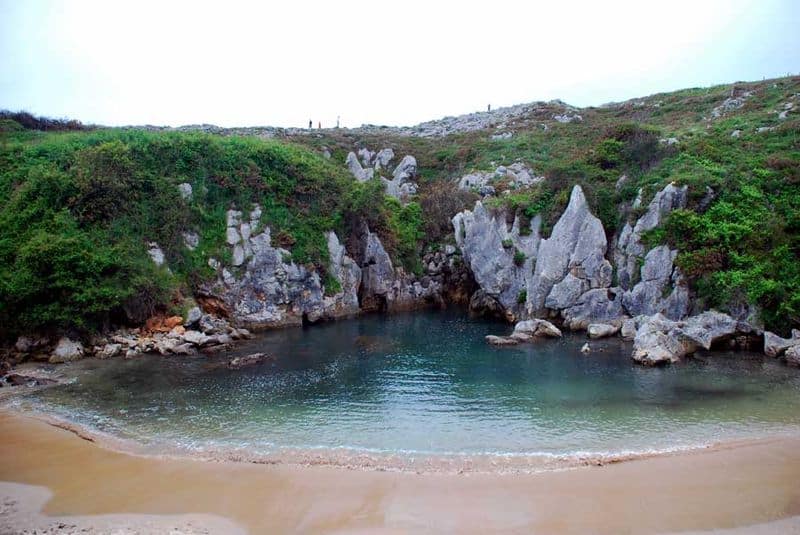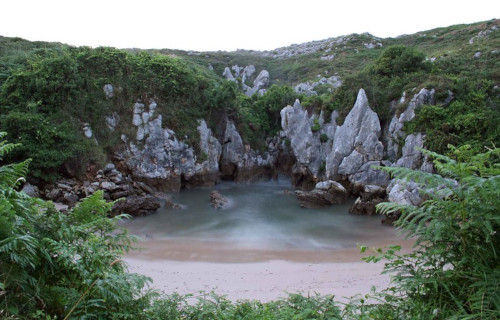It’s our hope that each of you, our readers, will enjoy and appreciate this article we present about these 3 Spectacular Marvels of Spain. It was certainly our pleasure to gather the information for you. May it provide you with both education and increased awareness.
Certainly, these formations listed herein represent only a portion of the wonders found throughout this amazing region. It’s our belief, though, that they serve as excellent representations of the marvels found here. Check out some of our other articles, as well.
Rio Tinto
Rio Tinto Facts
- Leading off this article about these 3 Spectacular Marvels of Spain we give you the breathtaking flow bearing the simple name of Rio Tinto.
- The short yet distinctive term given to it serves as the Spanish name for an incredibly unique river that must be seen to be believed. Not surprisingly, though, the remarkable body of water only maintains its distinctiveness over part of its length.
- While not many people outside of its immediate area know of it, the river has a rich and storied history. It has also long served various important economic purposes in its part of the world. One of these also explains its eye-catching coloring.
- The entire region around this marvel of Nature boasts an extensive history of ore-mining. In point of fact, records of this process taking place along its length extend back roughly 5,000 years. Multiple civilizations also used it for this purpose, in fact.
- Among the most notable of these remains the ancient civilizations of the Greeks and Romans. Other also used it, though. A few of these included the societies of the Phoenicians, Moors, and the Visigoths, just to name the most prominent.
- In ancient times, the mining processes around the stunning Rio Tinto primarily focused on gold, silver, and copper. In more modern times, however, this expanded to include other ores. Chief among these comes manganese and iron.
Rio Tinto Physical Description
The remarkable Rio Tinto also has a respectable length, measuring roughly 62 mi (100 km). Only part of the body of water, however, displays the unique appearance for which it’s know known. This portion of the marvel of Nature extends for about 31 mi (50 km).
Extending over a length equaling roughly half the total of the river, an incredible phenomenon exists. This portion of it manifests the incredible array of colors you see here. These include such hues as red, orange, and shades of brown, though the red predominates.
The water of this section of Rio Tinto itself has an extremely acidic nature. It’s also high in levels of certain metals, most specifically iron. Near the end of the multi-colored section, this aspect of the body of water also slowly begins to thin out, to eventually disappear.
Rio Tinto Location, Formation, and Ecology
The stunning wonder of Nature the man calls Rio Tinto further formed in a section of the world well known for its natural beauty. In point of fact, this geological gem formed in a small portion of the southwestern section of what’s now the continent of Europe.
More specifically, though, its precise region now constitutes the country of Spain. In this beautiful location, the waters of the river originate high in the Sierra Morena Mountains, in the Andalusia region. From there, though, the river flows primarily south-southwesterly.
At precisely what point in the past the river itself formed presently remains undetermined. The origin of the enormous deposits of the various ores in the region, however, has been determined. These deposited via hydrothermal activity between 300 – 350 million years ago.
Given the incredible extremes inherent to the nature of the water of Rio Tinto, one might not expect to find life within it. That would be an incorrect belief, though. Although life remains scant and quite unique within its waters, small amount of its does appear.
This primarily consists of various types of microorganisms, largely consisting of different forms of algae. Relatively large quantities of anaerobic bacteria reside within the sediments it contains, possibly contributing to the condition of the waters.
Playa de Gulpiyuri
Playa de Gulpiyuri Facts
- The next amazing site chosen to appear in this listing of 3 Spectacular Marvels of Spain is the incredible site known by the term of Playa de Gulpiyuri.
- The astounding work of geological forces ranks as one of the smallest, yet most amazing, beaches in the world. The astounding site additionally actually represents an inland beach. Astonishingly, though, it’s not one accompanying a river.
- This remarkable geological feature further formed located near what now represents the region of Llanes, Spain. This lies on the northern coast of the country, and also forms part of what’s now Spain’s Regional Network of Protected Areas.
- Not surprisingly, the marvel of Nature even holds the distinction of having been named a natural monument, as well. Playa de Gulpiyuri also, quite understandably, now represents an extremely popular tourist attraction across the region.
- However, the site can be difficult to locate and reach, which helps to preserve it. It remains one of the few hidden beaches in the world, yet most experts believe it to be the only one of its kind on earth that has a fully tidal nature.
Playa de Gulpiyuri Physical Description
The remarkably picturesque, and completely unique, Playa de Gulpiyuri also constitutes perhaps the smallest ocean beach on earth. That’s principally due to the nature of its formation. This simply provides further proof that tiny can be beautiful.
It measures roughly 131 ft (40 m) in length, while its width averages about 65.5 ft (20 m) when the tide is at its lowest. The site also formed a mere 328 ft (100 m) from the Cantabrian Sea. That fact only serves to augment its natural charm and wonder.
The reason for its fully tidal nature remains the existence of a network of small underground tunnels connecting it to the ocean. This amazing direct link to its source provides another marvel. It actually allows for the creation of minor wave activity.
The uniqueness of this wonder of Nature does not end there, though. That’s because Playa de Gulpiyuri also sits tucked away in a small hollow area, set into the ground. This hollow region itself lies almost perfectly in the center of a lovely green meadow.
Playa de Gulpiyuri Formation and Preservation
The remarkable Playa de Gulpiyuri was actually formed by the combination of two separate natural events. Therefore, the rarity of this action serves to give it a unique distinction. Only a handful of similar sites exist in the world.
Uniquely, the endless activity of the ocean waves carved several small tunnels into the sea cliffs over a great period of time. Then, although scientists remain uncertain of when it happened, a naturally occurring sinkhole formed, forming the site.
Eventually, the relentless motion of the waves augmented what had begun, creating the marvel we currently see today. That’s because their implacable movements washed away the debris and deposited sand, and thus a beach was formed.
Finally, the site is not widely advertised, to help protect it in its current condition. Tourists from around the world visiting the area hear about it from local inhabitants, however. These frequently inundate it during warmer parts of the year.
Gibraltar Rock
Gibraltar Rock Facts
- Closing out this composition about 3 Spectacular Marvels of Spain we give you the world famous creation of natural forces known as Gibraltar Rock.
- The term used herein serves as one of the alternate names for the world renowned formation known as the Rock of Gibraltar. By whatever name one chooses to call it, however, this marvel of Nature holds a particularly impressive distinction.
- That’s because this massive outcropping remains one of the best known natural formations on the planet. Its renowned doesn’t end there, though. This stunning example of the works of Nature also holds a special importance for another reason.
- That holds true due to the fact that a significant portion of the upper area of the feature also forms a special Nature Reserve. This small Reserve, along with the indigenous flora, fauna, and geology of the region remain enormous tourist favorites even today.
- It stood out in the minds of mankind even in the distant past, as well. The mighty Gibraltar Rock held roles of importance going back as far as ancient times. This held true for several reasons, some of them involving local mythology.
- Firstly, ancient Phoenician and Greek sailors named it one of the Pillars of Hercules, and believed it to mark the end of the known world. Secondly, the Romans later knew of the astonishingly impressive natural site, and called it Mons Calpe.
Gibraltar Rock Physical Description
The truly remarkable formation known to many as the Gibraltar Rock represents a fascinating study in geology, for those of a scientific mindset. For those having a more literary way of thinking, it makes an imposing image in various beliefs.
In purely technical terms, the incredible site qualifies as what geologists of today presently call a monolithic promontory. That’s because this awesome location constitutes a raised mass of land that projects into a lowland or a body of water.
Only enhancing its aura of majesty, the truly impressive Gibraltar Rock has an amazing physical nature. For starters, the gargantuan rock clearly features a highly sharpened crest. This displays points standing as much as 1,398 ft (426 m) in height.
The main prominence itself, however, measures roughly 1,388 ft (423 m) in height. Its basic structure also consists primarily of greatly eroded dolomites and ancient limestone. Other mineral compounds remain present, of course, but in small quantities.
Gibraltar Rock Location, Formation, and Nature Reserve
The massively impressive Gibraltar Rock easily sits in a unique position. This statement holds true for several reasons. The magnificent structure formed in what now constitutes the British Territory of Gibraltar, situated on the Iberian Peninsula.
As part of the United Kingdom, this marvel of geological processes additionally lies on the southwestern tip of Europe. It even forms part of the border with the country of Spain. It also forms a large peninsula that projects out into the Strait of Gibraltar.
Mostly composed of limestone, parts of the monolith dissolved over time due to the actions of the water. This natural process also often forms caves. In the case of this site, more than 100 caves exist. St. Michael’s Cave remains the best known of these.
The Nature Reserve located here forms 40% of the area of Gibraltar Rock. Much of the flora and fauna found there continue to be of importance to conservationists. The best known of these are the Barbary Macaques, with roughly 300 individuals located within the Reserve.
This collection currently comprises the only known wild monkey population in Europe. But the natural wonder of this formation does not simply end there. That’s due to the fact that other endemic species of prominent interest also inhabit the area.
In fact, of ecological importance equal to the Barbary Partridges, plant species such as the Gibraltar Candytuft appear here, and nowhere else in Europe. Finally, the stunning site also serves as a major resting point for large populations of migratory birds.
3 Spectacular Marvels of Spain
We hope that each of you thoroughly enjoyed reading, and hopefully learning from, this article we’ve written about these 3 Spectacular Marvels of Spain. It’s also our hope that doing so has left you with either a new or renewed appreciation for such wonders of Nature.
Unfortunately, many other such features around the world now find themselves facing threats to their continued existence in an undamaged state. Many of those dangers, in fact, stem from the actions of mankind. We must do all we can to protect and preserve them all.
Check out our other articles on 4 Lovely European Lakes, Wonderful Wild Cats of the World, 5 Incredibly Wonderful Trees, Earth’s Many Stunning Waterfalls


